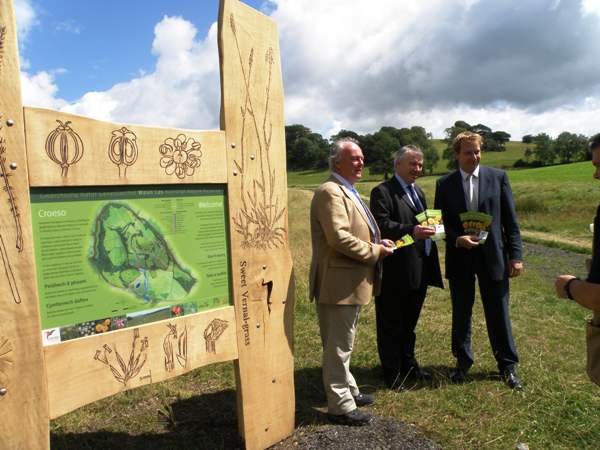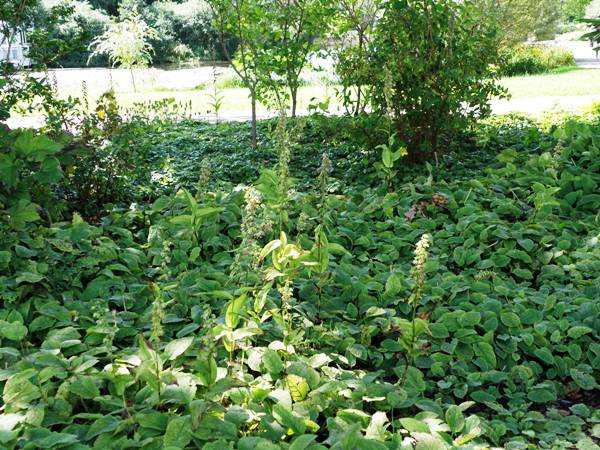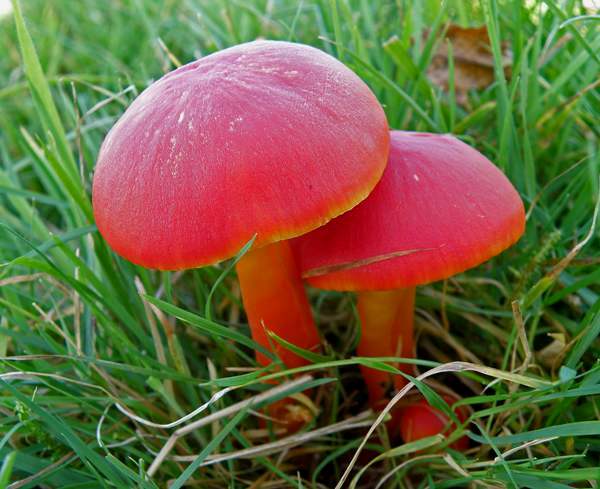Waun Las National Nature Reserve, Llanarthne, Carmarthenshire, South Wales
Designations: NNR
Below: The official opening of Waun Las NNR. Pictured are John Lloyd Jones of CCW, Ieuan Wyn Jones of the Welsh Assembly Government and Kevin Lamb from the National Botanic Garden of Wales.

This NNR is one of the most recently designated in Wales; its entrance lies within the National Botanic Garden of Wales. The reserve occupies some 150 acres of lovely countryside which has been managed as an organic farm for more than ten years.
Interesting features on the site include parkland, with traditionally managed hay meadows, and ancient semi-natural woodland with interesting plants. The real jewel here, though, is the diversity of grassland fungi; in particular, Waun Las is famous for its rare waxcap mushrooms. The best time to see them is in Autumn - September, October and November are the best months - and the Garden of Wales arranges fungi forays to enable visitors to get the best from their visit to the NNR at that time of year.
The site is managed by the National Botanic Garden of Wales.
Directions
Grid Ref: SN528179
The National Botanic Garden is signed from the M4/A48M Cardiff to Carmarthen motorway.
There is plenty of parking at the National Botanic Garden's car parks.
Access
It is a five-minute walk from the entrance gate of the National Botanic Garden to Waun Las NNR.
It is not possible to visit this NNR without paying for admission to the National Botanic garden of Wales. Entry to the Garden in 2011 cost £8.50 per adult and £4.50 per child per day.
Season (membership) tickets are available.
Below: Broad-leaved Helleborines grow in the National Botanic Garden

Facilities
The reserve has an Information Board, and leaflets are available at the entrance to the Garden. There are public toilets, a gift and book shop, a plant shop and several cafés in the Garden itself.
Once in the NNR there is a circular walk in and around the hay meadows, which are full of wildflowers in the spring and summer. Further paths are likely to be opened soon. Access to the best area to see the Waxcap fungi is through a rather marshy area and involves climbing up a fairly steep slope so secure. Waterproof shoes are therefore recommended.
The woodland, Pont Felin Gat, can be found on the northern edge of the reserve and access to it was opened in 2010.
Description of Site
As you walk up through the National Botanic Garden on your way to the NNR entrance, there is much of interest to see. There are a number of naturally planted areas, some restored lakes with wildfowl, and in some of the flower beds, there are plenty of Broad-leaved Helleborines Epipactis helleborine; they bloom at the end of June and on through July.
Looking at the magnificent walled garden and the mature flower beds it is hard to believe that this lovely garden has only been in existence for just over 10 years. There is also a large glass-domed garden featuring plants from all over the world. A separate tropical glasshouse, sited within the Walled Garden, contains the Botanic Garden's collection of exotic orchids and many other tropical plants.
Once in the nature reserve you will see the meadows stretching out ahead and on both sides of the main path. Apart from plants typical of such habitats there is also a good population of Greater Butterfly-orchids Platanthera chlorantha; they come into bloom in mid-June.
Some of the woodland is quite wet and has Alder trees Alnus glutinosa with Tussock Sedge (Carex paniculata) growing beneath. Look out for themany lichens that cling to the trees, especially in the more humid parts.
Below: Hygrocybe spendidissima - one of the colourful waxcaps at Waun Las NNR

Twenty-two kinds of waxcaps have been recorded from Waun Las NNR. These grassland fungi are frequently referred to as the 'orchids of the fungi world' because they appear in a wonderful array of bright colours: pink, crimson, scarlet, yellow and green all feature in the wonderful extravaganza that takes place every autumn at the reserve.
The Parrot Waxcap Hygrocybe psittacina, for instance, starts off being a bright green and then turns a variety of other colours from yellow right through to orange or sometimes purple. Some waxcap mushrooms are a pure, glistening white - Cuphophyllus virgineus is a common one - while Hygrocybe coccinea is a bright crimson. Without doubt my personal favourite is Porpolomopsis calyptriformis, the Pink Waxcap which does indeed have a striking pink cap above a whitish stem.
Waxcaps get their name from their shiny, wax-textured caps that always look as if they have just been rained on.
From Another Kingdom
On Friday 18th March 2011 a touring exhibition entitled From Another Kingdom opened in the Great Glass House at the National Botanic Garden of Wales. The exhibition explores the world of fungi from its origins on the planet up to the present day, and explores the impact that fungi has on our lives. The various exhibits demonstrate how fungi grow, where they live and how they multiply, and (at least in part) they explain how to differentiate the delicious from the deadly. This exhibition is highly recommended to all those with an interest in fungi - and for those who have never given fungi a second thought before, we can promise that you will do so after visiting the show!